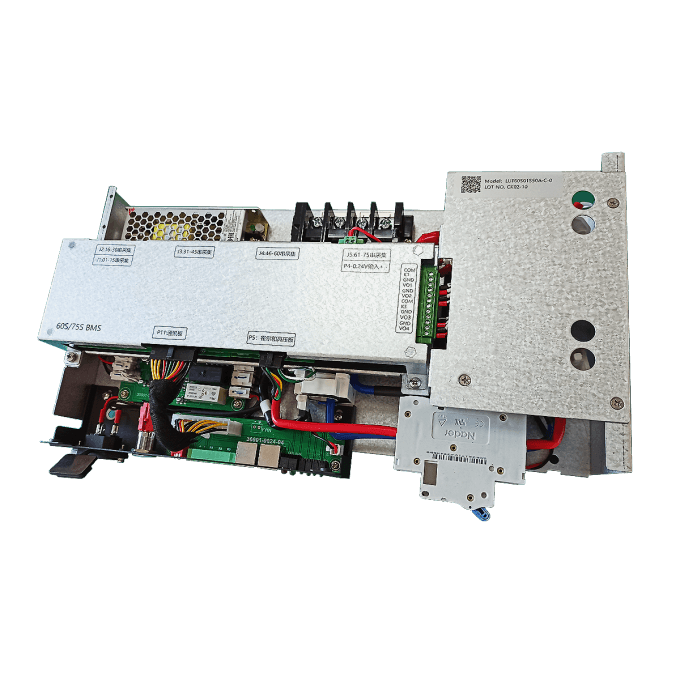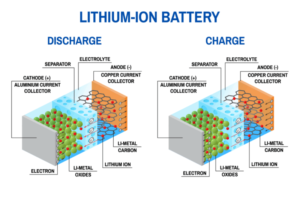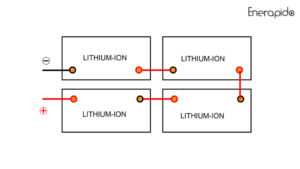Lithium Battery BMS – Battery Management System (BMS) plays a crucial role as a subsystem of the Lithium Battery & Energy Storage System (BESS). It is responsible for monitoring the operational status of each battery unit in the BESS to ensure safe and reliable operation.
BMS battery management system can collect and monitor real-time state parameters of energy storage batteries, such as single battery voltage, battery pole temperature, battery circuit current, battery pack terminal voltage, insulation resistance of battery system, and more. By analyzing and calculating these parameters, BMS obtains system state evaluation parameters, which help to effectively control the energy storage battery body through specific protection control strategies. This ensures the entire BESS operates safely and reliably.
Additionally, lithium ion BMS can exchange information with external equipment such as Power Conversion System (PCS), Energy Management System (EMS), and fire protection systems, among others, through its own communication interface, analog/digital input, and input interface. This helps to link and control various subsystems within the entire energy storage power station, ensuring safe and reliable operation and efficient grid-connected performance.
Types of Lithium Battery BMS
There are two types of BMS management system based on different project requirements: Centralized and Distributed. Among these types, Centralized BMS is the most commonly used by consumers.
Centralized BMS
Centralized BMS collects data from all batteries using a single BMS hardware, making it suitable for scenarios with a small number of batteries. It has the advantages of being low-cost, compact, and highly reliable. Typically, it is used in scenarios with low capacity, low total voltage, and small battery systems such as electric tools, handling robots, power-assisted robots, IOT smart homes, electric forklifts, electric low-speed vehicles, and light hybrid vehicles.
The hardware of Centralized BMS can be divided into two sections: high-pressure areas and low-pressure areas. The high-pressure area collects the voltage of each individual battery, the total voltage of the system, and monitors the insulation resistance. The low-pressure area comprises the power supply circuit, CPU circuit, CAN communication circuit, and control circuit, among others.
Distributed BMS
Distributed BMS, on the other hand, is mainly used in plug-in hybrid and pure electric vehicles as the power battery systems of these vehicles have high capacity, high total voltage, and large volume.
The functions of Lithium Battery BMS
- Status Management
- Balance Management
- Security Management
- Communication Management
Status Management
Status Management – Measurement and Estimation. The primary function of lithium BMS system is to measure and estimate battery parameters, including basic parameters and states such as voltage, current, and temperature, as well as calculating battery state data such as SOC (State of Charge), SOH (State of Health), SOP (State of Power), and SOE (State of Energy).
Cell Measurement
BMS in lithium battery measures the voltage, current, and temperature of the battery cell, which serves as the basis for the top-level calculation and control logic of all battery management systems.
Insulation Resistance Detection
BMS conducts insulation resistance detection of the entire battery system and high-voltage system to ensure safety in the battery management system.
High-Voltage Interlock Detection (HVIL)
BMS confirms the integrity of the entire high-voltage system through HVIL and initiates safety measures when the integrity of the high-voltage system circuit is damaged.
SOC ( State Of Charge )
BMS calculates SOC, which indicates the remaining capacity of the battery, i.e., how much power is left in the battery.
SOC is a critical parameter in BMS, as it serves as the foundation for all other battery management functions. Therefore, its accuracy and robustness (also known as error correction capability) are of utmost importance. Without accurate SOC, BMS protection functions would not work correctly, leading to frequent battery protections and shortening battery life.
SOC, which is a core control algorithm of BMS, represents the current state of remaining capacity. BMS employs the ampere-hour integral method and EKF (Extended Kalman Filter) algorithm, in combination with correction strategies such as open circuit voltage correction, full correction, charging end correction, capacity correction at different temperatures and SOH (State of Health), to calculate and improve the accuracy of SOC.
SOH ( State of Health)
Refers to the health status (or degree of deterioration) of a battery. It is mainly used to describe the current health status of the battery, with a numerical value ranging from 0% to 100%. It is generally considered that the battery is no longer usable when its health status is below 80%. SOH can be represented by changes in battery capacity or internal resistance. When using battery capacity to represent SOH, the actual capacity of the current battery can be estimated through battery operation data, and the ratio of the actual capacity to the rated capacity is the SOH.

Balance Management
Even batteries produced by the same manufacturer in the same batch have unique characteristics and a varying life cycle. This is due to two reasons: production inconsistency and electrochemical inconsistency.
production inconsistency
Production inconsistency occurs when there is a lack of uniformity in the diaphragm, cathode, and anode materials during the battery production process, leading to different overall battery capacities. For example, a 100AH battery may have one cell with a capacity of 98AH and another with a capacity of 101AH.
electrochemical inconsistency
Electrochemical inconsistency arises from differences in the thermal environment during the charging and discharging process. Even if the production and processing of two batteries are identical, the resulting electrochemical reaction will never be the same due to variations in temperature. For instance, battery modules require a higher temperature at the edges than in the middle, resulting in long-term differences in charge and discharge capacity and causing inconsistencies in battery capacity. Furthermore, inconsistencies in the aging of the SEI film can occur when there are inconsistencies in charge and discharge currents over a prolonged period.
To address these inconsistencies, balancing technology is used in BMS to ensure that each cell in the battery pack has a consistent state of charge. This technology can be classified into passive and active balancing methods.
Why is balance management necessary?
Inconsistency among batteries can have a negative impact on the performance of the battery pack.
This is due to the barrel short-board effect, which means that in a series-connected battery pack system, the capacity of the entire system is limited by the unit with the smallest capacity.
The depth of discharge, or the percentage of battery discharge capacity to the rated capacity, is affected by battery inconsistency, which can lead to decreased performance of the battery pack.
In energy storage system, where long life and deep cycle are important requirements, the BMS must have a strong balance management capability to minimize inconsistency among battery cells, ensuring the full release of capacity during deep charge and deep discharge.
This is particularly important for large-scale battery modules with multiple strings of batteries connected in series, where the voltage difference between cells can result in decreased capacity of the entire battery pack, with the loss increasing as more batteries are added in series.
electrochemical inconsistency
There are two common equalization methods: energy dissipation type one-way equalization (passive equalization) and energy transfer type two-way equalization (active equalization).
Passive equalization
The principle of passive equalization is to connect a switchable discharge resistor in parallel with each string of batteries. The BMS controls the discharge resistor to discharge the cells with higher voltage, and the electric energy is dissipated in the form of heat.
Passive equalization technology
it can only discharge the cells with high voltage, but cannot supplement the cells with low capacity. Limited by the power of the discharge resistor, the equalization current is generally small (less than 1A).
The advantages of passive equalization are low cost and simple circuit design; the disadvantages are that equalization is performed based on the lowest remaining battery capacity, and the capacity of a battery with a small residual capacity cannot be increased, and 100% of the balanced power is wasted in the form of heat.
Active equalization technology
multiple series of batteries use algorithms to transfer the energy of high-voltage batteries to low-voltage batteries by means of energy storage components, and discharge the batteries with higher voltage, and the released energy is used to charge batteries with lower voltage. The monomer is charged, and the energy is mainly transferred rather than dissipated.
When charging, let the battery B whose voltage reaches 100% first self-discharge to A and C, and the three batteries can be fully charged at the same time; when discharging, when the remaining power of battery B is too low, let A and C “charge B” “, so that cell B will not touch the SOC threshold to stop discharging so quickly.
Security Management
Security Management – Fault Diagnosis and Alarm – The BMS for lithium battery monitor matches the hardware of the electrical system. According to different performance conditions of the battery, it is divided into different fault levels (minor faults, serious faults, fatal faults), and different processing measures are taken under different fault levels: warning, power limit or Cut off the high voltage directly. Faults include data acquisition and plausibility faults, electrical faults (sensors and actuators), communication faults, and battery status faults.
Common example: When the battery is overheated, the BMS judges that the battery is overheated based on the collected battery temperature, then disconnects the circuit that controls the battery, performs overheating protection, and sends an alarm to the EMS and other management systems.
Communication Management
The normal operation of the BMS is inseparable from the communication function of the BMS. Whether it is controlling the battery during battery management, or transmitting the battery status to the outside, and receiving control commands, stable communication is required.
In the power battery system (electric vehicles, low-speed vehicles, marine boats, RVs, etc.), one end of the BMS is connected to the battery, and the other end is connected to the control and electronic systems of the vehicle. Most of them use the CAN protocol for communication transmission (excellent transmission stability). It is only based on the use of internal CAN between the internal components of the battery pack, and the use of vehicle CAN between the battery pack and the entire vehicle.
In contrast, energy storage BMS basically adopts CAN protocol or RS485 for internal communication, but its external communication (external mainly refers to energy storage power station dispatching system PCS) often adopts the Internet protocol format TCP/IP protocol and modbus protocol.
The necessity of BMS management system
In order to intelligently manage and maintain each battery unit, prevent the battery from over-charging and over-discharging, prolong the service life of the battery, monitor the state of the battery, and take necessary measures to alleviate the inconsistency of the battery pack, thereby maximizing the cycle life of the lithium battery.





